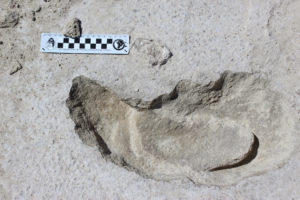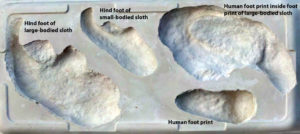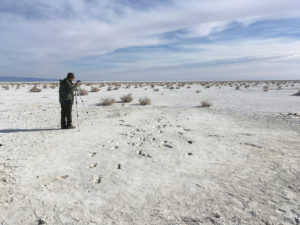
Science Advances—At White Sands National Monument in New Mexico, an international team has uncovered fossilized footprints of humans for the first time, and notably, the human prints were inside those of fossilized footprints from giant ground sloths – tall creatures with sharp claws. The results suggest that human hunters stalked these large, now-extinct animals thousands of years ago, helping to paint a picture of how ancient humans and animals interacted, in this instance. Researchers have been studying fossilized footprints for decades, a way to understand how different species related with one other, but predator-prey interactions revealed by vertebrate fossils (particularly those that could shed light on human hunting practices) are extremely rare. Now, however, at White Sands National Monument, researchers led by David Bustos and using the latest geophysical techniques have unearthed the tracks of not only animals, but also of humans – with the latter being “inside” the former, providing evidence that humans followed closely behind, or even “stalked” the sloths. What’s more, say the authors, the sloth tracks show evidence of evasion and defensive behavior when associated with human tracks, leading Bustos and his team to infer that humans may have been hunting these animals in the late Pleistocene, a period when many large mammals went extinct. Understanding the way in which our ancestors tackled big prey is important because big animals like this would have been associated with greater risk to their human predators. The results may also help shed light on any role humans may have had in the extinction of giant ground sloths, the authors say.
____________________________

Human footprint inside a sloth track. This composite track is part of a trackway in which the human appears to have stalked the sloth. Matthew Bennett, Bournemouth University
____________________________

Composite cast showing a range of footprints from the White Sands National Monument (WHSA) field site.
David Bustos, National Park Service
____________________________

General view of Alkali Flat at White Sands National Monument (New Mexico) showing a series of excavated footprints in the foreground. Matthew Bennett, Bournemouth University
____________________________

Reconstruction based on the fossil footprint evidence showing how human hunters stalked giant ground sloth to distract them before trying to land a killing blow. Alex McClelland, Bournemouth University
____________________________
Article Source: Science Advances news release. Science Advances is published by AAAS, the nonprofit science society.
____________________________





